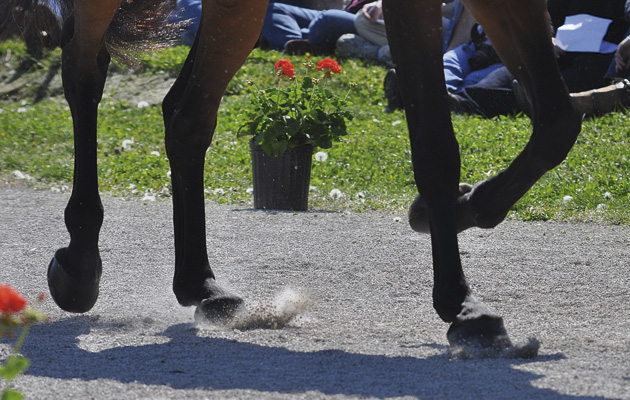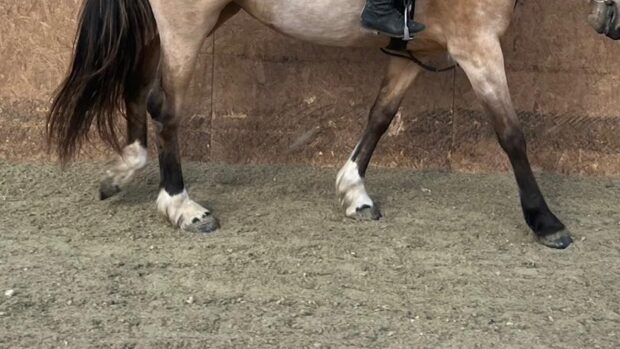Rick Farr of Farr & Pursey Equine Vets shares his expert advice on check ligament injuries and how to best treat them
Q: Check ligament injuries: “My dressage horse was diagnosed with a check ligament injury four weeks ago when I found a swelling on his leg. He has never been lame on it and is not lame now. My vet scanned it four weeks ago and advised two months box rest with the first two weeks completely confined to his stable with no walking out. Then after this two weeks he said to start walking him out either in hand or under saddle beginning at 10 minutes a day building up each week until we are road walking for an hour and a half. After this we would then start to look at trotting.
“My horse was doing well and his leg had gone down a lot, then yesterday morning when I took off the bandage it was swollen again. He still isn’t lame however. I’ve decided to get the vet back tomorrow and not walk him over the weekend.
“I’ve had so many different treatments suggested, some say total box rest for six weeks, some say turn away — what is your advice on treatment and what is the prognosis for such injuries?”
A: From your description I presume you are talking about a forelimb and, most likely, the ‘accessory ligament of the deep digital flexor tendon’ (ALDDFT). This is a short ligament located just below the knee and is a direct continuation of the palmar carpal ligament, which joins/merges into the deep digital flexor tendon (DDFT) in the middle cannon bone. Its main role is to provide stability as the knee fully extends and, in the mid-stance phase of the stride, also shares the tensile load of the limb with the DDFT.
Continued below…
Related articles:
- H&H forum: find out what H&H readers suggested
- All about suspensory ligament injuries
- Read more on tendons and ligaments in horses
So why and how does this ligament get damaged? I usually describe the ALDDFT as a ‘fail safe’ for the DDFT. When the DDFT comes under excessive load as the knee and fetlock fully extend something has to ‘give’. This is usually the ALDDFT — which is better than rupturing the DDFT! The extent of damage always varies, however the damage and subsequent lameness is usually sudden in onset and is commonly associated with localised soft tissue swelling just below the knee on the back of the limb.
Ultrasound is the mainstay of attaining a definitive diagnosis and it is important that the ALDDFT is compared in both limbs and equally the DDFT and Superficial Digital Flexor Tendon (SDFT) are also checked as concurrent damage to surrounding soft tissue is equally as common, especially when associated with profound lameness.
It is common to see and feel persistent thickening to the area surrounding the ALDDFT post-injury and, as you have already pointed out, this is not always associated with lameness.
Historically we used to rest all tendon and ligament injuries, however we are starting to appreciate that specific controlled exercise is crucial in any convalescent period. Given enough of a chance (especially when damage is more profound) adhesion formation to the ALDDFT’s surrounding soft tissues is common. This will result in mild lameness during early exercise phases. However, it is important to note that with controlled exercise and monitoring progress with ultrasound it is possible to get many horses back into full work.
At our practice we advise horses are re-scanned around 4-6 weeks after the initial diagnosis and follow-up scans are repeated every 4-6 weeks if lameness persists. Occasionally, if adhesions are noted, localised injection of substances such as sodium hyaluronate can help to reduce their formation. Correction of any foot imbalances is also imperative.
As a general ‘rule of thumb’ clinical improvement usually precedes what is deemed normal on an ultrasound scan. Clinically we tend to find most horses are completely sound within 3-9 months.

The prognosis for returning to full athletic performance in an uncomplicated case of damage to the ALDDFT is good.
I have included our ‘generalised’ exercise plan which we give to patients with uncomplicated cases — having most horses back into work within three months, which you can see above. I should emphasise that every case is different and should be managed on its own individual merits. Careful discussion with your vet post ultrasound, in conjunction with your own horse’s tolerances to controlled exercise, should always be made.
For all the latest news analysis, competition reports, interviews, features and much more, don’t miss Horse & Hound magazine, on sale every Thursday.




